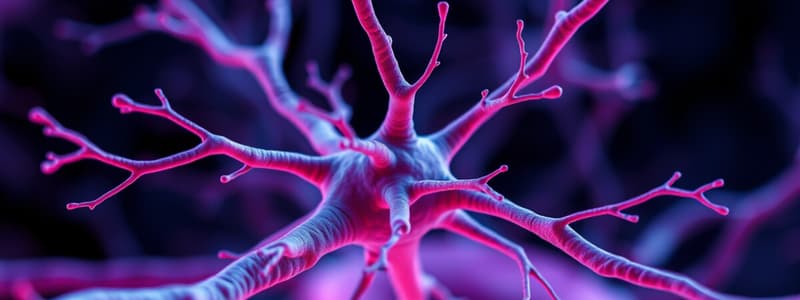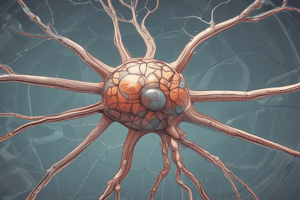Podcast
Questions and Answers
What is the primary function of dendrites in a neuron?
What is the primary function of dendrites in a neuron?
- To insulate the axons and increase impulse speed
- To propagate electrical impulses to the axon terminal
- To create synaptic contacts with effector cells
- To receive information from other neurons (correct)
Which part of the neuron is responsible for generating the nerve impulse?
Which part of the neuron is responsible for generating the nerve impulse?
- Myelin sheath
- Axon terminal
- Dendrites
- Cell body (soma) (correct)
What role does the myelin sheath play in neuron function?
What role does the myelin sheath play in neuron function?
- It speeds up the transmission of electrical impulses (correct)
- It stores neurotransmitters
- It generates electrical impulses
- It transmits signals to other neurons
Where are synaptic contacts made in a neuron?
Where are synaptic contacts made in a neuron?
What defines the cluster of neuron axons in the nervous system?
What defines the cluster of neuron axons in the nervous system?
In the context of neuron functionality, what does the term 'integration' refer to?
In the context of neuron functionality, what does the term 'integration' refer to?
What is the primary chemical agent released at the axon terminal?
What is the primary chemical agent released at the axon terminal?
Which of the following statements is true regarding electrical impulses in neurons?
Which of the following statements is true regarding electrical impulses in neurons?
What type of sensory function detects changes in muscle stretch?
What type of sensory function detects changes in muscle stretch?
In a simple reflex arc, what is the role of the interneuron?
In a simple reflex arc, what is the role of the interneuron?
What is the primary function of a sensory receptor in the reflex arc?
What is the primary function of a sensory receptor in the reflex arc?
Which of the following is a characteristic of the stretch reflex?
Which of the following is a characteristic of the stretch reflex?
What symptom is associated with damage to the spinal nerve at L4?
What symptom is associated with damage to the spinal nerve at L4?
How does reflex testing provide diagnostic information about neuronal damage?
How does reflex testing provide diagnostic information about neuronal damage?
Which condition reflects hyperactive reflexes as a symptom?
Which condition reflects hyperactive reflexes as a symptom?
What is indicated by flaccid paralysis in the leg?
What is indicated by flaccid paralysis in the leg?
What initiates the action potentials in a simple reflex response?
What initiates the action potentials in a simple reflex response?
In a clinical case, what would be a common reason for referred pain?
In a clinical case, what would be a common reason for referred pain?
What type of receptors monitor blood pressure in the body?
What type of receptors monitor blood pressure in the body?
If a patient exhibits no voluntary movement in the leg and also shows increased muscle tone, what type of injury is most likely?
If a patient exhibits no voluntary movement in the leg and also shows increased muscle tone, what type of injury is most likely?
Which step in the reflex arc follows the detection of stimuli by sensory receptors?
Which step in the reflex arc follows the detection of stimuli by sensory receptors?
What can be inferred if a patient has stretch reflexes rated +4?
What can be inferred if a patient has stretch reflexes rated +4?
What implication does a painful skin eruption caused by shingles have regarding nerve function?
What implication does a painful skin eruption caused by shingles have regarding nerve function?
How does the body respond to increased muscle tone in the context of motor neuron compression?
How does the body respond to increased muscle tone in the context of motor neuron compression?
What triggers the release of a neurotransmitter at the axon terminal?
What triggers the release of a neurotransmitter at the axon terminal?
How does myelin influence the conduction speed in axons?
How does myelin influence the conduction speed in axons?
Which is NOT a component of the Central Nervous System (CNS)?
Which is NOT a component of the Central Nervous System (CNS)?
What happens to a neurotransmitter after it binds to receptors on the other neuron?
What happens to a neurotransmitter after it binds to receptors on the other neuron?
Which statement best describes the Peripheral Nervous System (PNS)?
Which statement best describes the Peripheral Nervous System (PNS)?
What is the role of sodium channels in an unmyelinated axon?
What is the role of sodium channels in an unmyelinated axon?
What is the primary type of communication at the synapse?
What is the primary type of communication at the synapse?
Which divisions make up the autonomic nervous system?
Which divisions make up the autonomic nervous system?
How can drug binding to plasma proteins affect drug efficacy in the kidneys?
How can drug binding to plasma proteins affect drug efficacy in the kidneys?
What does the bioavailability of a drug determine?
What does the bioavailability of a drug determine?
Which of the following is a consequence of developing drug tolerance?
Which of the following is a consequence of developing drug tolerance?
Why are pharmacokinetics crucial in evaluating a drug's usefulness?
Why are pharmacokinetics crucial in evaluating a drug's usefulness?
What happens if a drug is broken down by low pH in the stomach?
What happens if a drug is broken down by low pH in the stomach?
What is a key factor in determining the concentration of a drug at its target site?
What is a key factor in determining the concentration of a drug at its target site?
Which of the following describes how pharmacokinetics and pharmacodynamics work together?
Which of the following describes how pharmacokinetics and pharmacodynamics work together?
What effect does increasing the dose and frequency of a medication have over time?
What effect does increasing the dose and frequency of a medication have over time?
Flashcards are hidden until you start studying
Study Notes
Introduction to the Nervous System
- Neurons transmit electrochemical messages called nerve impulses to other neurons and effectors (muscles or glands).
- Key parts of a neuron:
- Cell body (soma): Contains nucleus and produces proteins.
- Dendrites: Input area; branched projections that receive information.
- Axons: Integration area; long fibers that propagate electrical impulses (action potentials) from cell body to axon terminal.
- Axon terminal: Output area; nerve endings that make synaptic contacts and release neurotransmitters.
- Myelin sheath: Insulating cover that enhances the speed of impulse transmission.
- A single neuron integrates multiple inputs (inhibitory/excitatory) to produce one output (action potential).
Neurotransmission Process
- Electrical communication at the axon terminal converts to chemical communication via neurotransmitter release.
- Neurotransmitters bind to receptors on adjacent neurons, creating new action potentials.
- Deactivation of neurotransmitters occurs when they are reabsorbed by the axon terminal.
Myelin and Conduction Speed
- Myelin sheath allows action potentials to jump between sodium channels, promoting rapid electrical conduction.
- Unmyelinated axons require channels to open sequentially, which slows conduction.
Divisions of the Nervous System
- Central Nervous System (CNS): Comprises the brain and spinal cord; brain has external grey matter (cell bodies) and internal white matter (axons); spinal cord has internal grey matter and external white matter.
- Peripheral Nervous System (PNS): Comprises spinal nerves (31 pairs) that connect spinal cord to body segments; includes sensory and motor functions.
- Sensory (afferent) Functions: Includes somatic sensory (touch, taste, smell, hearing, vision) and autonomic sensory functions (chemoreceptors, stretch receptors, baroreceptors).
Reflex Arc Components
- Components of a reflex arc:
- Stimulus detection by sensory receptors.
- Sensory information relayed to the CNS via sensory neurons.
- Action potentials transferred to motor neurons via interneurons.
- Effectors respond to stimuli.
- Example: In a stretch reflex, a muscle stretch is detected, leading to a contraction response (e.g., knee-jerk response).
Diagnostic Use of Reflex Testing
- Reflex testing helps identify damage in the CNS or PNS by observing the presence or absence of reflexes.
- Deficits and symptoms can provide clues about affected nerves based on the vertebral level of spinal nerve injury.
Patient Comparison for Motor Neuron Damage
- Patient A: No stretch reflex, absent voluntary movement, flaccid paralysis - indicates damage at the spinal nerve (L4).
- Patient B: Hyperactive stretch reflex, absent voluntary movement, spastic paralysis - indicates upper motor neuron compression.
Pharmacokinetics and Drug Effectiveness
- Pharmacokinetic processes affect drug action duration, bioavailability, concentration at target sites, and potency.
- Effective drug treatment relies on both pharmacokinetics and pharmacodynamics to ensure the drug reaches its target and remains effective.
- Additionally, long-term medication use can lead to drug tolerance, requiring dose adjustments for therapeutic effect.
Studying That Suits You
Use AI to generate personalized quizzes and flashcards to suit your learning preferences.




